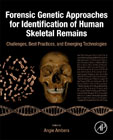
Forensic Genetic Approaches for Identification of Human Skeletal Remains: Challenges, Best Practices, and Emerging Technologies
Ambers, Angie
Forensic Genetic Approaches for Identification of Human Skeletal Remains: Challenges, Best Practices, and Emerging Technologies provides best practices on processing bone samples for DNA testing. The book outlines forensic genetics tools that are available for the identification of skeletal remains in contemporary casework and historical/archaeological investigations. Although the book focuses primarily on the use of DNA for direct identification or kinship analyses, it also highlights complementary disciplines often used in concert with genetic data to make positive identifications, such as forensic anthropology, forensic odontology, and forensic art/sculpting. Unidentified human remains are often associated with tragic events, such as fires, terrorist attacks, natural disasters, war conflicts, genocide, airline crashes, homicide, and human rights violations under oppressive totalitarian regimes. In these situations, extensive damage to soft tissues often precludes the use of such biological samples in the identification process. In contrast, bone material is the most resilient, viable sample type for DNA testing. DNA recovered from bone often is degraded and in low quantities due to the effects of human decomposition, environmental exposure, and the passage of time. The complexities of bone microstructure and its rigid nature make skeletal remains one of the most challenging sample types for DNA testing. Provides best practices on processing bone samples for DNA testing Presents detailed coverage of proper facilities design for skeletal remains processing, selection of optimal skeletal elements for DNA recovery, specialized equipment needed, preparation and cleaning of bone samples for DNA extraction, and moreHighlights complementary disciplines often used in concert with genetic data to make positive identifications, such as forensic anthropology, forensic odontology, and forensic art/sculpting INDICE: 1. Introduction2. Challenges to DNA Recovery from Skeletonized Remains3. Collection, Packaging, and Transport of Human Skeletal Remains4. Preparation of Human Skeletal Remains for DNA Testing5. DNA Extraction Methods for Human Skeletal Remains6. Quantification of DNA Recovered from Bone 7. Autosomal Short Tandem Repeats (STRs)8. Lineage Markers9. Single Nucleotide Polymorphisms (SNPs)10. Insertion/Deletions11. Traditional Approaches12. Alternative Strategies to Improve Data Recovery from Challenged Samples13. Emerging Technologies for DNA Analysis of Challenged Samples14. Low Copy Number (LCN) Interpretation15. DNA Databases, Population Data, and Cataloging of Reference Samples16. Direct Identification of Human Skeletal Remains17. Kinship Analysis in the Absence of Direct Reference Samples18. Bioinformatics Tools for Data Analysis19. The Emerging Discipline of Forensic Genealogy20. Forensic Anthropology21. Pathological Conditions and Manifestations of Disease in Skeletal Remains22. Forensic Odontology23. Forensic Art and Sculpting
- ISBN: 978-0-12-815766-4
- Editorial: Academic Press
- Encuadernacion: Cartoné
- Páginas: 500
- Fecha Publicación: 01/03/2021
- Nº Volúmenes: 1
- Idioma: Inglés
